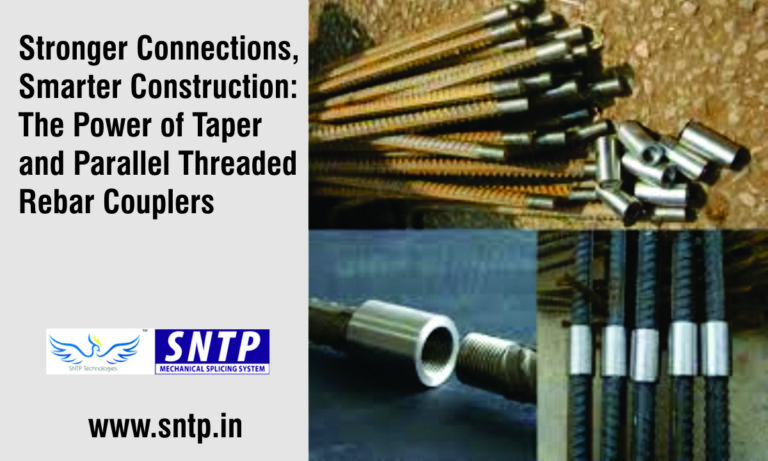+91 9953 65 9594

Stronger Connections, Smarter Construction: The Power of Taper and Parallel Threaded Rebar Couplers
In modern construction, ensuring structural strength and safety is more critical than ever. High-rise buildings, bridges, tunnels, and metro projects demand reliable reinforcement systems capable of handling immense loads while maintaining precision and efficiency. Traditional lap splicing methods for connecting rebars often fall short, leading to material waste, weak joints, and alignment challenges.
This is where Taper threaded couplers and parallel threaded rebar couplers come into play. These advanced mechanical connectors offer stronger connections, faster installation, and superior structural integrity, transforming how engineers approach construction.
SNTP Technologies®, India’s first BIS-certified company for rebar couplers, has pioneered these solutions, combining world-class engineering with rigorous quality standards to redefine reinforcement technology.
What Are Rebar Couplers?
A rebar coupler is a mechanical device that joins two steel reinforcement bars end-to-end, creating a continuous load path without overlapping. Unlike traditional lap splicing, which relies on overlapping bars to transfer stress, couplers ensure mechanical continuity, providing stronger, safer, and more durable connections.
Rebar couplers are particularly important in high-stress applications, including:
- High-rise towers and skyscrapers
- Bridges, flyovers, and flyway piers
- Tunnel and underground infrastructure
- Industrial and commercial heavy-duty projects
Among various types of couplers, taper threaded and parallel threaded couplers have emerged as the most effective for modern construction.
Taper Threaded Couplers: A Precision-Engineered Solution
Definition and Design
Taper threaded couplers feature a conical thread design, which allows rebars to be connected through a self-locking mechanism. The tapered threads ensure a tight fit that improves load transfer and prevents loosening under vibration or heavy stress.
Key Advantages
- Self-Locking Connection: The taper ensures the bars remain tightly connected under dynamic loads.
- High Load Capacity: Can transfer up to 100% of the parent rebar’s load.
- Alignment Accuracy: Tapered threads naturally guide bars into precise alignment.
- Faster Installation: Reduces time and labor compared to traditional lap splicing.
Applications
Taper threaded couplers are ideal for:
- Vertical joints in high-rise buildings
- Bridge piers and decks
- Tunnels and underground constructions
- Seismic-resistant structures
By combining safety, strength, and efficiency, taper threaded couplers have become a preferred choice for complex construction projects.
Parallel Threaded Rebar Couplers: Uniform Strength and Durability
Definition and Design
Parallel threaded rebar coupler utilize straight, parallel threads on both ends, ensuring even engagement and uniform load transfer. Unlike taper threaded couplers, they do not rely on a self-locking mechanism but provide consistent mechanical strength across the joint.
Key Advantages
- Uniform Load Transfer: Equal thread engagement ensures consistent stress distribution.
- Versatile Use: Suitable for various rebar diameters and structural applications.
- Durable and Reliable: Reduces the risk of thread stripping or misalignment.
- Prefabrication Friendly: Ideal for factory-assembled reinforcement cages and precast elements.
Applications
Parallel threaded couplers are widely used in:
- Metro and railway infrastructure projects
- High-rise commercial and residential buildings
- Marine and offshore structures
- Heavy industrial foundations
These couplers are preferred for high-volume projects where uniformity, productivity, and reliability are crucial.
Comparing Taper and Parallel Threaded Couplers
| Feature | Taper Threaded Couplers | Parallel Threaded Couplers |
|---|---|---|
| Thread Design | Conical/tapered | Straight/parallel |
| Locking Mechanism | Self-locking | Requires precise tightening |
| Load Transfer | Excellent tensile and compressive strength | Uniform and consistent stress distribution |
| Installation | Easier alignment | Requires careful torque control |
| Ideal Use | Seismic zones, vertical continuity | Prefabricated structures, heavy-load applications |
| Cost | Slightly higher | Economical for mass usage |
Both types outperform lap splicing in strength, safety, and efficiency, with the choice depending on project requirements and structural design.
Step-by-Step Installation Process
Installing threaded couplers requires precision and adherence to quality standards to ensure optimal performance:
1. Preparation
- Cut rebars squarely using precision cutters.
- Thread the bar ends according to coupler specifications.
- Clean bars and couplers to remove dust, rust, or oil.
2. Alignment
- Place the rebars in perfect line to ensure smooth engagement.
- Use alignment guides for vertical and congested reinforcement areas.
3. Assembly
- Insert the first bar into the coupler until it reaches the midpoint.
- Insert the second bar and tighten according to torque specifications.
- Ensure proper engagement and alignment.
4. Quality Verification
- Perform tensile tests and slip tests to confirm load capacity.
- Conduct visual inspections for thread exposure, gaps, or misalignment.
- Document all installation and testing results.
5. Concrete Pouring
- Ensure adequate concrete cover around the couplers.
- Prevent moisture or chemical exposure during curing.
Proper installation ensures the coupler achieves full load-bearing performance and structural safety.
Why SNTP Technologies® Leads in Rebar Coupler Innovation
SNTP Technologies® is India’s first company to receive BIS certification for rebar couplers, reflecting its commitment to quality, safety, and innovation.
Key Strengths
- Advanced manufacturing facility with precision threading machines
- ISO 9001:2015-compliant quality management
- Rigorous testing for tensile strength, load capacity, and dimensional accuracy
- Nationwide presence across critical infrastructure projects
SNTP’s couplers — both taper threaded and parallel threaded — are trusted by engineers to provide reliable, high-performance reinforcement connections in projects across India.
Benefits of Using Threaded Couplers in Construction
- Stronger Connections: Mechanical joints ensure full load transfer between rebars.
- Faster Installation: Simplifies alignment and reduces labor time.
- Material Savings: Eliminates overlapping, reducing steel usage.
- Improved Safety: Ensures consistent strength and reduces risk of structural failure.
- Durability: Resistant to corrosion and designed for long-term performance.
- Versatility: Suitable for a wide range of projects, from high-rises to bridges and tunnels.
Threaded couplers embody the principle of “stronger connections, smarter construction”, delivering efficiency, reliability, and safety simultaneously.
Conclusion
The introduction of taper threaded and parallel threaded rebar couplers has revolutionized reinforcement technology, offering unmatched strength, durability, and ease of installation. By replacing traditional lap splicing, these couplers optimize material use, enhance structural safety, and accelerate construction timelines.
With BIS-certified couplers from SNTP Technologies®, engineers and builders gain the confidence to execute high-rise, metro, and heavy-duty projects with precision and reliability.
In today’s infrastructure landscape, investing in advanced coupler technology is no longer optional — it’s a necessity for stronger, smarter, and safer construction.
© Copyright 2017.SNTP All Rights Reserved.
Design & Developed By Star Web Maker






